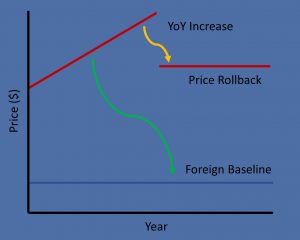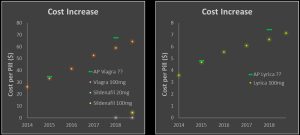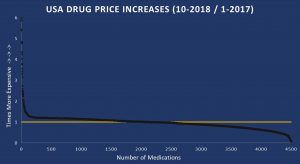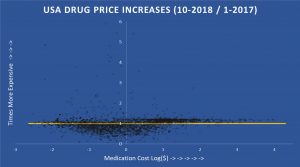Do the drug pricing conclusions made by the AP News match Apples Two Apples? Read on to find out.
When I read the AP article about 26,176 U.S. drug price changes this sounded very impressive not to mention the media attention. Definitely we agree with the AP’s conclusion that drug prices must come down and yearly price increases are part of the problem. However some of our unpublished analysis didn’t quite match the AP. Therefore our intellectual curiosity demanded further investigation. As a result we’ve analyzed 13,491 drug price changes from 2017 till October of 2018. As soon as we have additional resources 2014, 2015, and 2016 comparisons will be added.
Donation
Donation
In the first place it’s important to point out that 13,491 price changes is significantly easier to do than 30 apples to apples comparisons. For one thing collecting cash prices for our apples to apples comparisons is effort intensive. Also collecting foreign drug prices isn’t straightforward.
Comparatively more data points doesn’t necessarily provide more information. Although price changes are interesting observations of price manipulation this doesn’t necessarily provide a solution to the problem. As an illustration price rollbacks of an extremely excessive price will still be excessive when compared to foreign prices.

In light of our founding values public data is used whenever possible. As a result we use data from NADAC (National Average Drug Acquisition Cost) which is published by the U.S. government while the AP uses private data. With this in mind here are the results of NADAC drug prices compared to the AP article.
- Reasonably close match with the AP.
- Viagra brand name pricing is typical
- Price keeps going up
- Increases of 9%-27% each year
- Increase of 247% in 5-years
- Sildenafil is the generic form
- First sold this year
- Generic blocked in 2010 by Pfizer lawsuit
- 16x cheaper than the brand name Viagra
- Lyrica is a bargain in comparison
- Increases of 8%-31% each year
- Increase of 199% in 5-years
- AP highlights good examples
- There are hundreds (if not thousands) more drugs like this

- We evaluated year over year changes from January, 2017 to October, 2018.
- S-curve
- Points above 1 increased in price
- Points below 1 decreased in price
- S-curve
- ~50% of medications go up in price
- 12% of the medications price changed by less than 2.5%
- Many drugs don’t change significantly in price
- 12% of the medications price changed by less than 2.5%
- This is not a close match with the AP.
- The ratio of increasing versus decreasing drug costs is:
- AP has a 96:1 ratio
- We have a ~1:1 ratio

- We found consistent results with our earlier apples two apples comparisons.
- The higher the drug price the more likely it is to go up.
- Typically for brand name drugs.
- The lower the drug price the more likely it is to drop in price.
- Typically generics manufactured by several drug companies.
- The higher the drug price the more likely it is to go up.

By and large this is what we expected. Surprisingly we don’t know how the AP found so many drugs that go up in price because it doesn’t seem statistically possible. For one thing lower price generics tend to follow the behavior of the free market and drop once multiple drug companies compete. Even pharmaceutical executives openly admit drugs are priced as high as the market can bear. Similarly the AP and our team have found that in particular brand name drugs repeatedly increase prices to maximize profit.
On the other hand brand name drugs in foreign countries typically remain at the same negotiated price for years. For this reason quantifying how much U.S. drug prices increase misses the big picture. Instead the target drug price for the USA should be what foreign countries pay and that is often a fixed target. In conclusion brand exclusivity and the lack of pricing limits allow U.S. prices to be the highest in the world. Ultimately the U.S. system is designed for excessive drug prices.
Be First to Comment